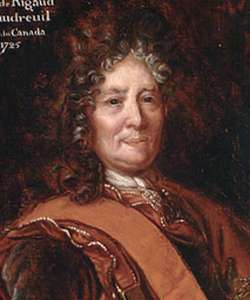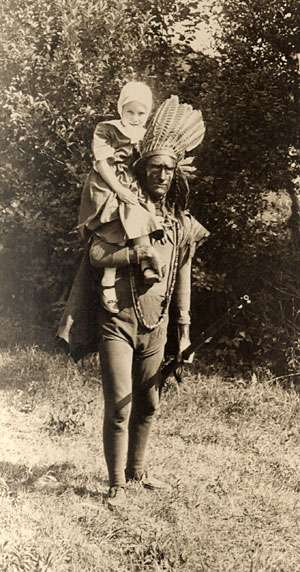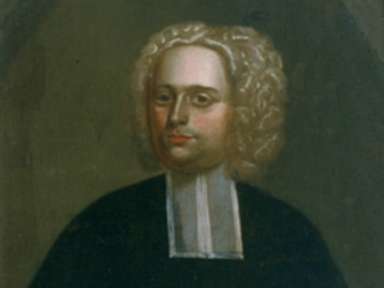In 1704, Mohawk Indians raided the frontier town of Deerfield, Mass. They captured local pastor John Williams, along with his family. Most of the family (those who didn’t die in the attack or aftermath) would be ransomed – all but a seven-year-old girl the Mohawks refused to free.
Eunice Williams, born Sept. 17, 1696, would spend the rest of her life with the Mohawks. She converted to Catholicism and married a Mohawk Catholic. Her family never gave up trying to bring her home, but when they finally reached her as an adult it was too late. She refused to return, and her Puritan family never got over the loss.
In Deerfield, John Williams was a prominent Puritan minister, married to Eunice Mather, the daughter of Eleazer Mather and first cousin to Cotton Mather.
War on the Frontier
In 1704 Queen Anne’s War raged along the frontier. The French and English fought for control of North America, and the Mohawk and Abenaki people allied with the French against England.
Historian John Demos believes the raid on Deerfield was masterminded by Marquis de Vaudreuil, governor of New France (Canada). He very much wanted the return of the mysterious pirate known as Capt. Pierre Maisonnat dit Baptiste. Baptiste had wrought havoc with English shipping on the Atlantic Coast on behalf of the French until t British captured him. Vaudreuil wanted the pirate returned, and the best way to do that was to capture an important English prisoner and offer him for exchange.
Vaudreuil quietly approached the Indians with his offer and they accepted, writes Demos in his award-winning book, The Unredeemed Captive.

An illustration of the raid on Deerfield, published around 1900
The Deerfield Raid
On the night of Feb. 28, 1704, a band of Abenaki and Mohawk Indians attacked Deerfield. They killed 39 people, including small children. They plundered possessions, set houses on fire and slaughtered cows, pigs and sheep. The Indians took 112 people captive, including the surviving members of the Williams family: John, Eunice, and five of their children, Samuel, 15, Esther, 13, Stephen, 9, Warham, 5, and Eunice, 7. Then they began the two-month journey through the snowy wilderness into New France.
The children and their father would survive the long winter journey. Their mother would not.

Philippe de Rigaud, Marquis de Vaudreuil. Was he ultimately responsible for the abduction of Eunice Williams?
By April 1704, the Indians took the Deerfield pastor and three of his children — Esther, Samuel and Warham — to Montreal. All four were turned over to the French authorities. They wouldn’t return home until further negotiations ended. Stephen was still at large in the woods with the Abenaki. He would stay with them for 14 months, until he was ransomed and sent to join his father in captivity in a small village near Montreal.
Eunice Williams
The Indians took Eunice Williams to live with Catholic Mohawks in a small mission fort near Montreal called Kahnawake. John Williams visited his daughter once, and she begged him to take her with him. He told her to pray and to remember her scriptures.
By 1706, five of the Williams family were ransomed and sent home. A Mohawk family that had lost a daughter to smallpox adopted Eunice Williams. The family gave her a new name: A’ongonte, meaning ‘she who has been planted like an ash.’ She was also baptized Catholic and given the name Marguerite.
Her father tried to arrange for her release, but the French intermediaries said the Mohawks “would as soon part with their hearts as the child.” She would later take the adult name of Kanenstenhawi.
Her father would spend the rest of his life trying to free the daughter he always knew as Eunice Williams.
In 1707, John Schuyler, a New York merchant who had many contacts with northern Indians and traders, heard about a sighting of Williams’ daughter. He also heard she didn’t want to return to her family. Schuyler stayed in touch with her Mohawk family in an effort to redeem her.
[optinrev-inline-optin1]In March of 1713 the Williams family learned the melancholy news that Eunice Williams had married an Indian. They were devastated.
Not Even A Look
John Schuyler visited her at Kahnawake. She had forgotten her English, and they needed a translator to communicate. Schuyler pleaded with her to return to her family. She said no, not even for a visit.
The next year, her father visited her. She did not give him so much as a pleasant look. He would never see her again.
Eunice Williams and her husband, François-Xavier Arosen, had two daughters who grew to adulthood, Catherine and Marie, and a son named John.
Eunice Williams Returns
After John Williams died in 1729, Eunice’s brother Stephen took up the task of bringing her back. He had become a minister in Longmeadow, Mass., and he persuaded her to meet in Albany with him, along with their brother Eleazer and brother-in-law Joseph Meacham. On Aug. 27, 1740, they had a ‘joyful, sorrowful’ meeting, and Stephen persuaded Eunice and her husband to visit them in Longmeadow for four days. They actually stayed a little longer, camping out in the orchard near Stephen’s house.
The next summer Eunice and Aronson brought their children first to Longmeadow to visit Stephen, then to Coventry, Conn., to visit her sister Esther. Finally they went to Mansfield, Conn., where they visited her brother Eleazer.
In 1743, Eunice Williams and her family came to spend the winter with her family in Longmeadow and Deerfield, where her brother Elijah lived. Stephen hoped that this long visit would persuade her to stay, but again she refused.
One Last Visit
She wouldn’t return for another 17 years. In 1761, she brought her husband, a daughter and son-in-law and grandchild to Longmeadow for a brief 10-day visit. Ten years later in 1771, she wrote a letter to Stephen, chastising him for not staying in touch and expressing a desire to see him again. Stephen died in 1782 without ever seeing Eunice again. She died Nov. 26, 1785 at the age of 89.
By the time she died, Eunice Williams had one grandson and 12 great-grandchildren. Two of her great-grandchildren were sent to school in Longmeadow, where they dropped their Indian dress and manners. One of them, Eleazer, would later make the fraudulent claim that he was the lost Dauphin – Louis XVII, the rightful heir to the throne of France.
In 1837, 23 descendants of Eunice Williams arrived in Deerfield, Mass., to visit the graves of their ancestor John Williams and his wife Eunice. They camped near the village and attended Sunday services. They stayed for 10 days, weaving baskets and selling fabrics to the villagers who visited them so often they could barely find time to eat their meals.
Eunice Williams’ descendants behaved “decently and inoffensively,” according to the prefatory remarks of a sermon delivered about their visit. And then they returned to Canada.
With thanks to The Unredeemed Captive: A Family Story from Early America by John Demos.
This story was updated in 2024. You may also want to read about the Rice boys, also taken captive by Indians, here.



43 comments
Well, the branches weren’t removed in this case – they continue to grow, as Eunice and Arosen produced many offspring whose lines continue today. A number of women who entered indigenous societies through kidnapping or other means refused to leave; Mohawk society, in particular, is matrilineal – property rights descend through women, and leaders are female. This represented a significant improvement in status for women coming from settler society.
we are trying to research our family tree. My grandfather Joseph Clinton Williams was dark eyed and darker skin. We are in northern WV. would like to know if any of the line came this far south.
wow!
very interesting!
Molly Jameson was a captive of the Senneca and when offered an opportunity as a young adult to return to “white society”, she refused. Her rights within the Senneca and her family connections were established. Her re-entry into settlement life would have been akin to house arrest–no rights, no friends, no income, no future. She was taken in a raid as retribution for the death of a Seneca child at the hands of the English.
Unredeemed Captive by Demos covers the story nicely
David Carabin – I wonder if this is the long lost Indian “cousin” referred to on our family tree?!
Could be or not, we have one too that was kidnapped in 1700’s and never came back
Stockholm Syndrome?
It is surprising to hear of the many instances of humane treatment of captives by their Native American captors. I visited the fort at no. 4 a few years ago and was told by a docent about the capture of Susanna Johnson, who gave birth days into her capture. The docent also talked about how women were often reluctant to return to a society where they had no rights. Here’s a link. http://www.fortat4.org/history.php
Cathryn Blackwell, I don’t think it is Stockholm Syndrome. I think the women were respected and treated as equal humans, which was typically not true in English society at the time.
The women and children taken were mercilessly slaughtered. Even the women too weak to keep up on the march to canada were tomahawked to death on front of their families.
My family is related to the Rice family whose sons were captured from Westboro, Mass. Some were redeemed, the others chose to stay with their tribe. One became a chief.
Interesting history!
Fascinating! Thank you.
Cant say as I blame her.
The Native American Indians knew the value of a girl and a women. Perhaps that is why they kept them and that is why they chose to stay!
Yes, it is haunting to visit the houses down there. One can get a sense of the past as you wonder the rooms.
That event tore many families apart and regardless of what political references some see, it must of been trauma like we really don’t understand today.
that is how one of my English ancestors got to marry a Frenchman in Montreal, their daughter in turn married a Poliquin from Quebec!
One wonders how much better life was with the natives for a woman, as opposed to life under the puritanical rule of the whites. And that she lived to the age of 89… almost unheard of for women in that day.
I think she grew up, moved to VT, and grew acres of kale so one day VT school kids could eat kale chips instead of brownies!!!
First sermon in vermont was preached in Rockingham, by Reverand Williams, when they fled north to Canada a great read
Fabulous mini-history lesson here. Thanks for sharing!
Fabulous mini-history lesson here. Thanks for sharing!
The book The Unredeemed Captive is probably the best history of this event ever written. I descend from many of the Deerfield families, almost everyone EXCEPT Rev Williams.
The book The Unredeemed Captive is probably the best history of this event ever written. I descend from many of the Deerfield families, almost everyone EXCEPT Rev Williams.
Yeah I bet that was great for a 7 year old to be kidnapped from her family.
Yeah I bet that was great for a 7 year old to be kidnapped from her family.
I’m descended from the Hinsdale family that was massacred in 1675 in that area. Father and all the boys were killed at Muddy Brook (renamed Bloody Brook). I was descended from the girl who stayed at home with mom.
Great history lesson
She lived a very long time…at least didn’t go thru any witch trials or any other horrible puritan accusations, frm that period.
The leaders in Mohawk society weren’t female. Women had a hand in picking the MALE chiefs.
[…] Passaconaway urged a policy of peaceful coexistence in the Merrimack and north to Maine, and that policy prevailed for many […]
I am a member of Kahnawake, the settlement where Eunice lived to a ripe old age, a longer lifespan than her surviving siblings. Just a few years before Eunice was born, the superstitious terror of the witch trials would transpire in Mass and she surely was aware of it being of a highly religious family rife with clerics. That and the chattel status of the female gender in the colony were powerful incentives to the young woman to adapt to Mohawk society, where women had a superior status. Just about every member of the Kahnawake community has Eunice back in their family tree, something the Jesuit priests kept up to date starting in the late 1600’s. Her husband, Francis Xavier Arosen (meaning “squirrel”) died in 1765.
[…] or redeemed, through the efforts of their families and Dutch traders. Others, like 7-year-old Eunice Williams, assimilated with the Indians and refused to return to their […]
My family descends from John and Eunice (Mather) Williams’ son Stephen, who was 9 at the time. The two youngest children were hatcheted to death (the youngest being days old). The mother was also killed after falling on ice during their kidnapping. It was no doubt a very traumatic experience for all. Reminds me of the Schenectady Massacre of 1690.
Most of us have ancestors who lived through incredibly traumatic events; we should remember their resilience as we go about our own lives.
That could certainly explain some blanks in our family . There were & still r many different colonies of tribes . They could have been friends or enemies that could have intermingled. Therefore not associated with the families they came from . Makes a lot of sense in missing families.
While doing genealogy to suss out rumors of native American ancestry the first anomaly found was a boy captured by the natives from what is now Maine, brought to Canada and raised by a French family. We also found a Stebbins girl who was also kidnapped at Deerfield. Is there a group for descendants of captives who refused to be redeemed?
[…] her father about the rituals the Mohawks performed, telling him they were “mocking the Devil.”[4] She’d described a French Catholic missionary who’d been making her pray with him. “I don’t […]
This site was… how do I say it? Relevant!! Finally I’ve
found something that helped me. Thanks a lot!
I am a descendant of Sarah Allen who was captured at the Deerfield Raid/Massacre.
She was taken to Kahnawake, sold to a French family at Baie d’Urfee, converted to Roman Catholic, was given a French name, married a neighbour lad, a Lalonde.
I have Williams ancestry too, but haven’t made a link with this family … yet!
Google
Below youll uncover the link to some sites that we think it is best to visit.
[…] terrified New England. Hundreds of warriors would strike swiftly and suddenly, burning villages, taking captives and slaughtering […]
Comments are closed.